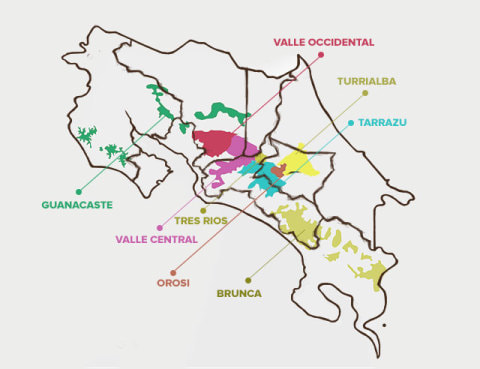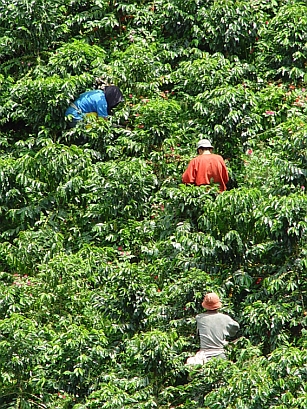The correct flavor and taste of different coffee bean producing areas in Colombia describes the coffee growing areas in Colombia.
Coffee beans from different producing areas will have changes in flavor, and Colombian coffee is very diverse. Each of the 20 coffee production sectors (out of a total of 32 in the country) produces coffee that is slightly different from the next.
In the northern regions of Santa Marta and Santander, lower elevations and higher temperatures give the coffee a strong aroma and a deeper flavor.
In the central "coffee belt" of Antioquia, Caldas, Quindio and other departments, coffee tends to be round, with nutty and chocolate flavors, mild sweetness and mellow acidity.
In the southern provinces of Nari ñ o, Cauca and Huila, coffee at higher elevations tends to have higher acidity, floral flavor and complex flavor.
In fact, it's not complicated, just like different kinds of coffee beans have different flavors, such as Blue Mountain Coffee, Manning and Rosa Coffee.
In front of the street, let's count the main producing areas of Colombian coffee.

Antioquia: Antioquia has been the "wild west" of the country for many years, initially settled almost entirely by gold miners. In the second half of the 19th century, the coffee sector's mountains, fertile frontiers were introduced, and Antioquia became one of the most important coffee producing areas in Colombia, made possible by ideal coffee growing conditions. the central and western mountains (mountains) pass through the sector. By the 1980s, coffee was the region's most important export. Although the sector is an ideal environment for boutique coffee producers, it has been neglected in Colombia's strong coffee production mix for many years. That is changing rapidly, in part because of the priorities of the department's current governor, Sergio Fajardo Fajardo. Fajardo was mayor of Medellin, the capital of Antioquia, a city known for years for violent and dangerous places. Fajardo has led a significant transformation of the city making it a world-class tourist destination with a strong economy. Coffee (and the added value produced by the sector) has always been at the heart of this transformation, and now Antioquia is a veritable coffee map. Of course, Mercanta and our partners in the region have also played a role here.
Cauca: Cauca's coffee includes the Inza area and the area around the colonial city of Popayan. The area is located on the "Macizo Colombiano" (Colombian plateau) and surrounds the peaks of Tolima and Wirat. In addition to being a major coffee grower, it is also an important source of water and wildlife.
Here Mercanta works mainly with an innovative and enterprising cooperative whose microbatch separation program has inspired many other producer organizations across the country. Each batch of coffee delivered to the cooperative is cup-tested and graded, and those scored 85 or more by the Association Cup Test Laboratory in Pedregar will be reserved for professional blends or small batches of coffee from a single producer. These strict standards result in a very limited amount of special mixtures of 70% + Caturra and about 30% Variedad Colombia that can be exported and further highlight the work of individual producers whose coffee was previously lost in larger batches.
Past violence in the region and the large number of FARC guerrillas have historically hindered the presence of FNC (Colombian National Coffee Council) and professionally focused exporters in the region. With the reduction of violence, growers in the region have been able to seek more high-quality market access, not only to take advantage of the wonderful coffee growing conditions in the region, but also to take advantage of the economic resources brought about by nearby tourist destinations (for example, the World Heritage site "Parque Nacional Arqueol ó gico de Tierradentro"). In the future, Mercanta fully expects the development of coffee in the region to become better and better.

Most of the coffee in Choc ó: Choc ó is grown near the city of El Carmen de Atrato, separated by a steep ridge from the fertile coffee-growing slopes in the southwest of Antioquia. The region, which is rich in biodiversity and is one of the most remote areas of Colombia, has been plagued by violence and isolation in the past due to the presence of the Revolutionary Armed Forces of Colombia.
The province of Choco Orientale is one of Colombia's most important coffee-producing regions in the late 19:00 and early 20th century; however, most of the sector is covered by dense and almost impenetrable tropical rainforest, which extends 100km eastward all the way to the Pacific Ocean. The coffee producing area of Choc ó is located in the mountains bordering Antioquia, and there is no other feasible route to transport coffee out of the sector, and almost all coffee from Choc ó is ground in Antioquia, which is then traditionally sold as Antioquia. In addition, market access challenges mean that Choc ó has paid less attention to coffee than its eastern neighbors over the past few years.
The neighbor (Antioquia) recently celebrated government plans and successes that inspired many producers in the region to reunite their coffee production efforts. Their efforts are supported by Cooperativa de Caficultores de Andes (Cooperandes), a Colombian cooperative working in five communities-Andes, Betania, Jar í n, Cuidad Bolivar, Hispania (all Antioquia) and El Carmen de Atrato (Choc ó)-and has been very active in promoting the production of high-quality coffee in the region. Mercanta started buying from the region in 2015, and the signs are good.
Huila: Huilan is more remote than Cauca; nevertheless, it is famous for the quality of its coffee and is rapidly becoming the largest coffee producing area in Colombia.
In Wirat, Mercanta works mainly with a cooperative that works with producers near the town of Timana in the south of the province. Every weekend during the Huila harvest, Asprotiman á members bring their parchment coffee to the town of Timan á. There, each cup of coffee is analyzed and tested by the association's team of professional cup testers, who have received the most stringent training standards. If the coffee comes from a grower who has previously produced very high quality coffee, or if the cup exceeds 84 points, the sample will be sent to Mercanta's partner Santa Barbara Estate Coffee, whose dry mill is located in Medellin. There, the Santa Barbara team served coffee again. Only the best coffee samples harvested each time will be sent to Mercanta for our own evaluation. During the 15-year harvest in 2014, Santa Barbara conducted cup tests on more than 1500 samples to select coffee that was separated into microbatches (10%) or included in the regional mixture (20%). Plans like this not only create better livelihood opportunities for small farmers in Wirat, but also create incentives to improve quality.
Nari ñ o: Narinho is located in the southernmost part of Colombia, bordering Ecuador at the peak of the Andes. Because of its proximity to the equator, the department can grow coffee at very high elevations, and many farms are located on hillsides more than 2000 meters above sea level.
Nari ñ o coffee producing areas have a variety of factors, such as 1666 hours of sunshine per year, 1866 mm (74 inches) of rainfall per year and reliable rainfall patterns, as well as soil with a high percentage of organic matter, all of which make it possible to grow coffee at high altitudes and below average temperatures.
If the heat accumulated at the bottom of the canyon during the day does not rise at night to reduce the cold in the alpine areas, it is almost impossible to grow coffee here. But in fact, it can make some very special coffee.
Santander: a lot of typica and shade coffee are grown here, most of which are certified by the Rainforest Alliance. The microclimate of this department is drier and grows at a lower altitude.
Sierra Nevada: the Sierra Nevada Mountains of Santa Marta is a mountain range isolated from the Andes, more than 5000 meters above sea level. On the northern coast of Colombia, many coffee farmers in this sector are part of the indigenous tribes of Arhuaco or Kogui. Most of the coffee here is grown organically, either certified or passively grown.
Tolima: southern Tolima has been a hotbed of FARC guerrilla activities for many years and a strategic area of Colombia's ongoing civil war. Most of the sector is difficult to access and the producers growing in the area tend to be small.
Important Notice :
前街咖啡 FrontStreet Coffee has moved to new addredd:
FrontStreet Coffee Address: 315,Donghua East Road,GuangZhou
Tel:020 38364473
- Prev

Colombian Palm trees and Big Bird Manor Coffee Story Lactic acid fermentation treatment of coffee bean flavor
Deeply in love with Manning https://m.gafei.com/views-136102 and Blue Mountain https://www.gafei.com/kafeixiaozhishi/20171026110691.htm, I did not expect that one day I would be attracted by lactic acid fermentation. Qianjie will introduce you to a coffee estate from Colombia, which is famous for its lactic acid fermentation.
- Next

Is Colombian instant coffee black? The difference between instant coffee and ordinary coffee powder
Customers often come to the Qianjie store to ask about our coffee powder, and then silently say: what's the difference between your coffee powder and instant coffee powder? In order to make customers understand quickly, I usually easily tell him that our coffee powder will leave coffee grounds when it comes out. Instant coffee is just like brewing milk. Write what is theorized
Related
- Detailed explanation of Jadeite planting Land in Panamanian Jadeite Manor introduction to the grading system of Jadeite competitive bidding, Red bid, Green bid and Rose Summer
- Story of Coffee planting in Brenka region of Costa Rica Stonehenge Manor anaerobic heavy honey treatment of flavor mouth
- What's on the barrel of Blue Mountain Coffee beans?
- Can American coffee also pull flowers? How to use hot American style to pull out a good-looking pattern?
- Can you make a cold extract with coffee beans? What is the right proportion for cold-extracted coffee formula?
- Indonesian PWN Gold Mandrine Coffee Origin Features Flavor How to Chong? Mandolin coffee is American.
- A brief introduction to the flavor characteristics of Brazilian yellow bourbon coffee beans
- What is the effect of different water quality on the flavor of cold-extracted coffee? What kind of water is best for brewing coffee?
- Why do you think of Rose Summer whenever you mention Panamanian coffee?
- Introduction to the characteristics of authentic blue mountain coffee bean producing areas? What is the CIB Coffee Authority in Jamaica?

